Journal
About Andrew Cusack
 Writer, web designer, etc.; born in New York; educated in Argentina, Scotland, and South Africa; now based in London.
Writer, web designer, etc.; born in New York; educated in Argentina, Scotland, and South Africa; now based in London. read more
News
Blogs
Reviews & Periodicals
Arts & Design
World
France
Mitteleuropa
Knickerbockers
Argentina
The Levant
Africa
Cape of Good Hope
Netherlands
Scandinavia
Québec
India
Muscovy
Germany
Academica
The Knights of Malta Ball 2006

BACK DOWN TO the Assembly Rooms of Edinburgh for the annual ritual of the Knights of Malta Ball and I am happy to report that, as per usual, a good time was had by all. We had a larger contingent heading down from the Auld Grey Toon than last year (when it was just Fräulein Hesser and myself), consisting of Abigail, Jon Burke, Stefano, Clare Dempsey, and yours truly. After gliding down from Fife via taxicab, we met up with Zygmunt Sikorski-Mazur, Jamie Bogle (sans Joanna, alas), and Gerald Warner at the Opal Lounge, a little past half six, and managed to pack in at least a round of drinks before heading across George Street to the Assembly Rooms (depicted in the engraving below).

Having dropped off our coats and such, we swept up the staircase to the Ballroom for some champagne before dinner. After mulling about and conversing for a while we bumped into the Cardinal Archbishop of St Andrews himself, H.E. Keith Patrick O’Brien, himself a Grand Cross Conventual Chaplain to the Order of Malta. We apologised for not maintaining his senior cathedral in St Andrews in the same state as his junior one in Edinburgh, but I did thank him profusely for allowing us an indult mass at Ravelston. (more…)
The Wedding

What a marvelous affair it was! And damn jolly to boot. We all had quite the ball and enjoyed ourselves immensely. But where to start? Right, the beginning…
Improvements
REACTIONARIES HAVE FOOLED themselves into believing the world has been getting worse and worse, essentially since the Fall. Progressives meanwhile, heartened by fairly recent progress-heralding genocidal masterpieces such as the French, Russian, and Chinese revolutions, believe the world is getting better and better with the March of Time. But we, the happy middle, – conservatives and traditionalists – know that Man is as Man was and as Man will be, and that we will see days of sadness and terror just as we will see days of greatness and glory. It was found to be greatly encouraging, therefore, when I chanced upon the Mess of the Officer Training Corps here in St Andrews last night and was greeted not by the bilious throbbing beats of noxious rap music, but instead by the dulcet syncopations of Tchaikovsky’s Swan Lake. Under the attentive ear of J.E.B., new President of the Mess Committee, A Squadron, TUOTC, I am happy to report that bad music has been given the old heave-ho.
YET, AS THE commendable is oft accompanied by the regretable, the hallowed pasttime of smoking has tragically been banned in the Mess. This is doubly wounding as the ban has taken place before the Scottish ban on smoking in public places takes effect (March 27), but also because the Mess is Ministry of Defence property and thus effectively exempt from the ban. Alas, the spirit of bureaucracy and nanny-ism has partly infected (some would say taken over) the caverns of the M.o.D. and decrees were handed down from above that smoking would be banned from January 1, 2006. Shameful, as it was one of the best places to enjoy a toke on the old pipe, especially since a pipe rack (donated by J.E.B. himself) was dutifully placed on the mantle below the portrait of Her Majesty. Nonetheless, we look forward to continued improvements under the tenure of Mr. J.E.B., and wish him well.
A Journey to Mells
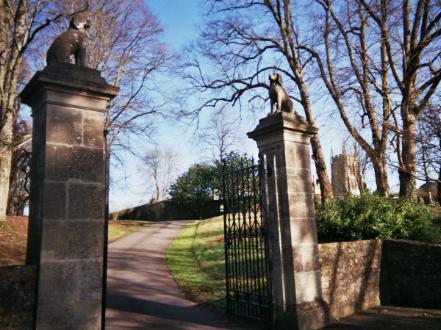
A good number of we happy St Andreans were down in the West Country recently — Somerset to be precise — for the wedding of two of our dear and closest friends [to be covered in a later post]. Being in Somerset, Alec, “Ishmael”, Clare and my good self decided to hop over to the little village of Mells last Friday to see the grave of Msgr. Ronald Knox and to sup at what is known as one of the best pubs in all of England. (more…)
Return and Remembrance
Well, yours truly has dutifully returned to hallowed Andreanopolis in pursuit of his last Candlemas term ever, to be capped off (Deo gratia) by the awarding of Master of the Arts degree this June. George Ronald Valentine Hastings Irwin picked me up from the airport on Friday morning and expressed his shock that he was graduating on time in the alloted four years and his even greater shock that I too am on course to complete the very same task.
As we drove down the Guardbridge Road towards our ancient seat of learning, the turrets, towers, and spires of the Royal Burgh were completely shrouded in haugh, that peculiar Scottish form of fog that rolls off the North Sea. Returning to dear old Sallies I came upon Dawn and Lisa, the two cleaners responsible for our corridor, chatting in the hallways (as is their wont), welcoming my return while lamenting my longer-than-ordinary absence. Most of the day was spent unpacking my various posessions. Because St. Salvator’s Hall was used to host a conference over the break, all the inhabitants thereof had been forced to pack away their belongings in storage. Thus after picking up my key from the porter and turning the lock on my room, I was greeted not by the welcome signs of my inhabitation but instead by a room bare but for the rearranged furniture, a different lamp (which doesn’t work, unlike the previous one), and the usual New International Version of the Holy Bible in the desk drawer.
Much to my lamentation, I quickly discovered that the great majority of my cohortem had skipped off to Pluscarden Abbey for a few days. Nonetheless, the trusty Alexander O’Hara was amongst the remaining and we met for a pint at the Whey Pat, just outside the town’s remaining city gate, before repairing to the Cellar Bar for a better brew. The following morning I met up with Ishmael for breakfast at the Victoria Café. [TEXT REDACTED]
After breakfast, I fell asleep in the library reading La Vita Nuova (apologies to Mr. Aligheri, but I did finish it when I awoke). After a woefully disappointing luncheon in hall, followed by ever-so-slighly less disappointing but more filling microwave meal to fill my empty belly, I watched Passport to Pimlico, the splendid Ealing Comedy in which the bombed-out inhabitants of a street in Pimlico discover an ancient document revealing that their home turf is actually an independent territory of the Duke of Burgundy. (Upon the revelation, the local Police Constable Spiller exclaims “Blimey, I’m a foreigner!”). When Whitehall bureaucrats interfere with the tiny statelet’s new-found freedom from pub licensing hours and the post-war remnants of rationing, the people of the district unite to defend their liberties in the long tradition of the English peoples. Quoth one character: “We always were English and we always will be English and it’s just because we ARE English that we’re sticking up for our right to be Burgundians!”
After attending the Vigil Mass at St. James, I had dinner at Abigail’s, after which a gang of us drank a few bottles of red while watching Bright Young Things, Stephen Fry’s directorial debut, which would have been much better if it had ended in the same manner as Vile Bodies, the novel by Evelyn Waugh on which the film is based. After that, we started House of Cards, of which I watched an hour before deciding it was necessary to retire. Woke up rather later this morning, missing chapel, but in time to lunch in hall whereupon I was informed by various chapelgoers that the new hymnal, previously delayed by a strike at the Finnish printing works where it is produced, has been introduced. We mused that since it was printed in Finland and the Muslim hordes are going after anything Scandinavian these days, we’re surprised the hymnal’s not being burnt in the streets at the moment. (My, how all conversation turns to Muslims on this side of the pond!). We mulled torching the nearest consulate of an Islamic country, but we concluded that would make us no different from the wicked ochlos, and remembered they have recently suffered a terrible disaster. “No doubt,” one bejant noted, “were it mostly Christians on the ferry, it would be extolled throughout the Muslim world as God reaking vengeance for the Danish cartoons.” After luncheon, I decided to write this post informing you, dear readers, of the latest.
In the mean time, Ezra Pierce texted from Oxford, reminding me of the Feast of the Holy New Martyrs, Confessors, and Passion-Bearers of Russia. Here is an icon depicting the martyrs, who include one of my favorite saints, the Grand Duchess Elizabeth, a widower of the Royal Family who became a nun and a great servant of the poor founding hosptials, convents, and orphanages. After the murder of Tsar St. Nicholas II and his immediate family, the Grand Duchess Elizabeth with a few other members of the Royal Family and their loyal servants who refused to leave them, were hurled down a mineshaft in Alapaevsk by the Communist Secret Police. Despite the great fall, they did not die, and so the Cheka threw grenades down the mineshaft, all of which refused to explode. The victims below could do nothing but sing God’s praises, quite literally, as they began to sang hymns and continued as the Communists sealed the mineshaft. When the bodies were recovered they were shown to have died of starvation. The icon in question also depicts the martyrdom of Archbishop Joachim, whom the Communists crucified, upside-down like St. Peter, on the Royal Doors of the Cathedral of Sebastopol in 1920.
These are stories rarely told, let alone heard, in the West where for so long this evil terror was praised in the lecture halls and academic presses of our universities and elsewhere. It is telling that in our nation’s capital today there is an entire museum devoted to the Holocaust, and similarly Holocaust memorials are worthily to be found in most major cities, while the victims of Communism are virtually forgotten. Not to denigrate the 10 million souls of the Holocaust, but it was small in comparison to first Lenin and Stalin, then Mao, the greatest mass-murderer of all time, and the dozens of murderous regimes spawned by the Russian Revolution. And unlike Nazism, which has been almost totally defeated, Communism and the ideas behind it have saturated the Western world and, while most (not all) of its despotic regimes have fallen Marxism continues to have great influence today.
Yet, at the end of the day, all that is left for us is to continue to pray and fight Evil wherever it may be found. They can destroy every single thing we hold dear – and rest assured they will try – except for our souls which belong to God. And should we find ourselves as victims of Evil we still have nothing to do but sing God’s praises like saints and martyrs of yesterday, today, and eternity.
Soggy Manhattan
Ah, Manahatta. Even on a day as soggy as this, the Upper East Side still charms me. It also retains a fair number of buildings from the days when New York had higher tastes, mostly to be found between Fifth and Park Avenues. It is a fact to be mourned that we have probably destroyed most of what was good in New York’s built environment. Nonetheless, we should of course be glad for the beautiful things which remain from our great city’s golden age, and thankfully they are not a mere handful.
Stumbling down East 82nd Street this afternoon amongst puddle, gloom, and rain I emerged onto Fifth Avenue to see the beautiful mass of the Metropolitan Museum of Art revealed in all its glory. The façade of the Met has recently been cleaned and glancing at it today, despite the cloud and percipitation, one could almost imagine the year as 1902 when the wing designed by Richard Morris Hunt was completed. This is doubly so because the Metropolitan currently lacks her usual ungainly vexillic adornments pronouncing the exhibits shown in her distinguished galleries. These banners add nothing to the Met’s façade, and if there is a more clever and handsome way of announcing what is within without – and surely there must be – the Museum does not seem to have found it.
Still, the situation is not as reprehensible as across Central Park at the American Museum of Natural History. The AMNH enjoys two façades, one of which commands the view over Central Park West and the park itself beyond. The main portion of the Museum’s Central Park West front is a brilliant triumphal arch which is in fact the State of New York’s monument and memorial to Theodore Roosevelt, President of the United States and Governor of New York during his earthly life. Shamefully, the Museum disrespects this great monument to this great man by covering it in advertising banners akin to those which usually mar the Metropolitan. The American Museum of Natural History should be ashamed of itself for sullying such an august and dignified locale for the purposes of selfish marketing.
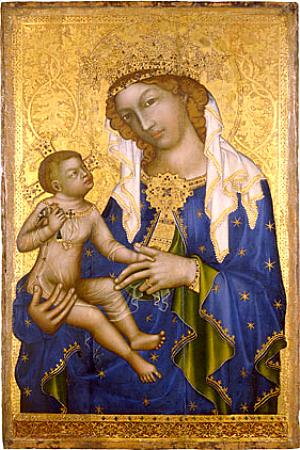
Tempera and gold on panel; 35′ x 23′
Deacon’s Office, Zbraslav/Koenigsaal/Aula Regia
(on loan to the National Gallery, Prague)
What brought me to plod up the splendid elevating staircase of the Metropolitan was to catch – just barely, for this was its last day – the special exhibition entitled Prague: The Crown of Bohemia 1347-1437. I had first gotten wind of this showing flipping through the mail whilst I was still interning at the New Criterion at the end of the summer and duly noted in my diary that though it opened while I was away in Scotland it would still be open upon my return for the Christmas holiday. Anyhow, I finally took advantage of it today and it was much enjoyed. What a remarkable land is Bohemia. The exhibit served only to augment my interest in the country and I must be sure to spend some time there sooner or later.
In addition to the Mother and Child above, the exhibit presented the tabernacle shown below (photographed in its actual home). There were also many, many reliquaries, some of which appeared to still have relics in them. One would have thought a museum’s interest in a reliquary was purely artistic and thus that the relics involved would be removed and handed over to those who would give them the care they deserve. Does the Museum have a consultant to advise on these cases, I wonder? Anyhow, I was sure to touch the glass and ask the saints to pray for us, just in case. The Bohemians clearly knew how to treat relics, would only that New Yorkers did – though to be fair I am told that the Tour of the Relics of St. Thérèse of Liseux which made its way to New York just a few years ago was well attended in the Metropolis and even up in Westchester round my neck of the woods. There is a relic of our dear Thérèse available for veneration in St. Patrick’s Cathedral which I occasionally drop in on when in the neighborhood.
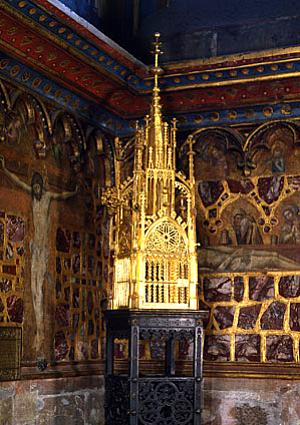
At any rate, had I attended Prague: The Crown of Bohemia 1347-1437 earlier I would’ve enjoined the reader to pay it a visit, but since it has finished its run I instead enjoin our dear readers to at least saunter down Fifth and stop to savor a glance of the cleaned-up Metropolitan sans banners. No doubt it will not be free of them for long — unless they who direct the Museum have had a moment of grace.
Previously: The Remarkable Hapsburgs | Brünn
Happy New Year!
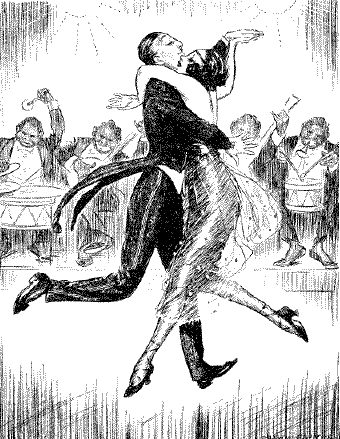
I hope everyone welcomed the New Year in style while I lounged at home.
Poor Hogarth, I made him drive the past year’s worth of andrewcusack.com (specially bound) to the Cusack archives at the New-York Historical Society first thing in the morning.
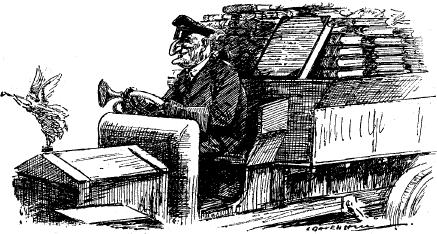
The Last Post of 2005
A Drink at the Gills’
The other day the Gills invited me over to dinner as the patriarch of the family, one of the most amusing men in lower Westchester (if not all of Westchester) was preparing his speciality of Shepherd’s Pie. The timing was unfortunate, however, since it was the nativital feast of my own pater familias and thus attendance was required at our own dynastic mastication of the evening meal. Nonetheless I agreed to head over Gill-ward a bit before dinner and enjoy a little drink. Caroline and Michelle, true to form, were late for dinner and thus I actually didn’t manage to see either of them before heading to Pop’s birthday feast but I did rather enjoy a nice civilised glass of red with Mater et Pater Gill and a family friend of their’s from Larchmont.
Lord and Lady Gill recently had the pleasure of hearing their younger daughter Lizzy sing in Carnegie Hall, though with the marked reservation that they considered it an ‘alternative’ concert, by which they mean to say it broke their usual statutory “Fifty-Year Rule” whereby they do not attend choral events unless the composer has been dead for at least half a century. To break this sacred doctrine, say the Gills, is to run the strong risk of becoming the latest victim of atonality and disharmony. (As an aside, any fans of atonality, ye poor wretched souls, would be interested to know that the Met is doing Berg’s Wozzeck this season). Nonetheless, Mr. and Mrs. Gill donned their noblesse oblige and attended. Besides, the two pieces Lizzy’s group were singing were Byrd and Tallis, if my memory serves me, so the offending parties were other participants in the concert, praise be.
Anyhow, the family friend from Larchmont asked me how I came to be friends with Caroline which provided me the splendid opportunity of telling the story of the first meeting of yours truly and dear old Caro.
A Young Lady Stuck in a Tree, or: That Wicked Day When We First Chanced to Meet Caroline
Well it was a fall day, perhaps winter, but at any rate it was during the school year. My alma mater was always in the habit of spoiling me by giving me a double-period for lunch which afforded me the time to travel back home for midday victuals, or to world-famous Walter’s in Mamaroneck, or to occasionally luncheon with comrades attending other establishments of secondary education. Well, as the occasion would have it I one day arranged to lunch with young Miss Emma Haberl, une lycéen of Bronxville High School. Emma asked if she might bring along her friend Caroline, and at the time a firm believer in the more the merrier I happily acquiesced to her proposal. The meeting place was agreed as the hour of one in the front courtyard of Bronxville High School.
Well, I duly arrived at the appointed time and place to discover a courtyard bare of any personages bar our Emma. “I thought you said your friend Caroline was coming?” I inquired. Emma was braced to reply when a shrill abrasive voice emanating from a nearby tree shouted “I’M STUCK IN THE TREE! I CAN’T GET DOWN” And, she told no lie, she was stuck in the tree, though I’m happy to report not for very long. We soon had her out and highed off to luncheon during which I managed to offend Caroline in all sorts of charming and hilarious ways.
Last Night’s Soirée Chez Brenner
The Brenners, a most intelligent and amusing family whose presence I always enjoy, threw a little holiday light-dinner-and-drinks sort of thing last night at their place over in Larchmont. Eldest son Adam and I are friends because we had a good friend in common back in our school days (none other than the famous Lucas de Soto). Adam, you see, was not blessed enough to be a Thorntonian; he had to suffer through all those years at Riverdale instead. Anyhow, Brenner decided to sample the university life over at St Andrews by doing a junior semester abroad during Candlemas Term of ’04. Twas the dinner for Adam’s twenty-first at the Caledonian in Edinburgh after which Whit ‘Lawrenceville Spirit Personified’ Miller and I missed the last train back to our little corner of Fife and had to wait ages in Waverley Station for a taxi from St Andrews to arrive. A gaggle of neds (or chavs or what-have-you) crawled out of their hovel and investigated the curiously well-dressed pair of Americans conversing by the taxi rank. Eventually we fended them off.
But digression has got the better of me. As I was saying, the Brenners threw a nice event last night, the Eve of New Year’s Eve, and there was some good conversation. Brenner’s roommate during his term at St Andrews, now a Presby seminarian at Princeton Theological, was also in attendance and it was good to catch up and see what’s what and all that. Another friend of the Brenners’, a lady sophomore in college, explained her hopes to spend a year in Argentina and so the few of us who have been took the liberty of pontificating about what to do and where to go and generally showing off our savoir-faire, etc., etc.
I took great pleasure in commiserating with elders around the buffet about how much we hate New Year’s and what a bother it is and how preferable it is just to stay at home. Personally, I think New Year’s is a bit of a farce. Any evening is one year past the same evening the year before, so why the need to make a big to-do of it? I’ve no idea. I’ve never been a fan of New Year’s Eve myself. Such a silly evening.
After the Party… to Fogarty’s
After the party had run its course I went down to Fogarty’s in town to have a pint with a few friends, though I soon abandoned them for Mr. and Mrs. Carroll (Michelle’s parents) who were infinitely better chat than the haggardly sextet with which I was supposed to be conversing. I had the privilege of hearing why the Carrolls decided to move to America (they originally hail from the Emerald Isle) and other fascinating and amusing tales. When the topic of my future, inevitable at this juncture of life, surfaced Mr. Carroll declared his belief that I’ve got the makings of a gentleman farmer in me. The older I get the more I grow fond of the idea of a rustic existence. Sure, once I’ve got a family to myself I’d much prefer to worry about my children falling into brooks and streams in the country rather than getting run over by some soccer mom in her Land Rover in suburbia. Anyhow, Mr. and Mrs. Carroll deserve prizes for the consistently high standard of banter they uphold. After all, high standards are hard to come by these days.
The Anti-Social Guide to New Year’s Eve
I have been rudimentarily clever in avoiding attendance at any social occasion this New Year’s Eve. By implying to the party on the West Side that I will be attending the soirée on E. 89th and implying to the party on E. 89th that I have already committed myself to attending the party on the West Side, all the while forgetting about the event on 14th Street I am comfortably lounging on the sofa at home in the Garden Room watching an episode of Rumpole of the Bailey which I’ve taken out from one of the neighboring villages’ public libraries. With the firm knowledge that my immediate social circle find this little corner of the web far too dull to for their browsing, adding to the fact that all will be pleasantly sloshed this merry eve, I am sure that none will come to knowledge of my little scheme.
Finale
All that remains then is to wish you all, dear readers, a most happy, holy, and enjoyable New Year and may the Lord continue to smile upon yourselves, your families, and all your loved ones!
Well Boo Hoo for the TWU!
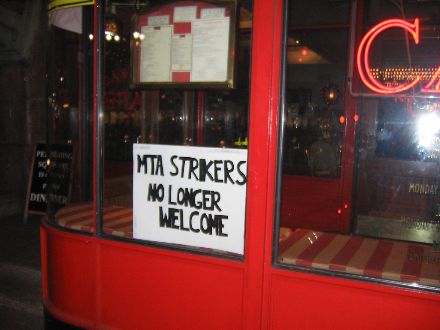
Well, the Great Transit Strike of 2005 is over with the Transport Workers Union having succeeding in winning for themselves the enmity of the entire city. The Trinidadian Roger Toussaint was elected head of the TWU on a radical platform and radical is what they got. And boy did it blow up in their faces! Listening to the radio the other day I heard stories of decent hard-working people who were waking up at 3:30 in the morning so that they could walk to their jobs and get there on time. Others were sleeping in impromptu locations at their place of employ. All this hassle just because Roger Toussaint wanted his pampered transit workers to retire at 55. Well boo hoo!
One Knickerbocker said: “Roger Toussaint gave up a life of hard work picking sugar cane down in the islands to come up to New York and pick the pockets of decent, hard-working Americans instead!” Well at least it’s all over now, so I can finally catch the Prague exhibit at the Met (oh and the Fra Angelico). I still curse myself for missing the Byzantium exhibit they held; I turned up a day late so I and the young lady who accompanied me assuaged our ire at J.G. Melon’s.
Whilst perusing the British corner of the Hudson Newsstand in Grand Central, waiting for a train home last Sunday after hearing Mass at St Agnes and then attending the Festival of Nine Lessons and Carols at St Thomas, I chanced upon a copy of This England, a splendid and reactionary quarterly from that green and pleasant land. It was something of a rediscovery as I have somewhere two copies of This England from 1983 and I am happy to report that the magazine has changed very little. It is a wonderful collection of little articles, stories, anecdotes, and charivari about the Mother Country and doesn’t give the slightest hoot for political correctness. A cozy and comfortable quarterly which I believe any traditionalist from the English-speaking world will enjoy. Irritatingly they did not have the Christmas double edition of the beloved Spectator, so I fear I must do without it this year. (And there was much gnashing of teeth…).
The Festival of Nine Lessons and Carols was superlative as always. It was interesting to note that in the program/weekly bulletin the word ‘Episcopal’ was nowhere to be found, nor any indication that St. Thomas is a parish of the Episcopal Diocese of New York and likewise the Episcopal Church of the United States of America except a very brief statement mentioning that the parish is “in the Anglican tradition”. A parish in denial? Perhaps, but if you were in their situation would you want to face facts? Ignorance is bliss, and it was a blissful service after all. Much enjoyed. My only complaint was that I thought the choir could’ve put a little more oomph in the final verses of Once in Royal David’s City and O Come All Ye Faithful, perhaps with a little help from the organ, but oh well, I’m no choirmaster, deo gratias.
Almost everyone in our little arrondissement of the web has been chiming in with their thoughts on the recent Chronicles of Narnia film, The Lion, the Witch, and the Wardrobe. I have little to contribute other than to say I found it an enjoyable film which I warmly encourage others to see. We found Father Christmas’s lack of headgear disappointing. A mitre would’ve been most appropriate, but his head was bare; perhaps Saint Nicholas should look to the much-vaunted final word in matters sartorial currently sitting on the throne of Peter.
Speaking of matters sartorial, a kerfuffle recently erupted in Missouri when some Communist enemy of all that good and holy banned a kilted student from a high school dance on the grounds that he was not properly attired. If I can trust my profound study of Scottish history (which consists mostly of the first few minutes of that 1959 biopic of John Paul Johns in which Robert Stack plays the title role) then we recall that the boorish Hanoverians banned the kilt for reasons I have forgotten. (I haven’t seen the film in years, and Robert Stack is dead, r.i.p.). I am certain that my readers and I are united in scorn.
I called up the folks at the New Criterion yesterday and Cricket Farnsworth, that hilarious and ever-charming daughter of Connecticut, answered the phone. I asked if there were any commuting woes and Cricket, the token liberal on the staff, just said “Well of course everyone here thinks the union leaders should all be shot.” “Then all is as it should be, Cricket,” I replied, “all is well in the world.” Happily, they have put one of the Jacksons’ Roger Kimball gingerbread men (or ‘Kimballbreadmen’ as they are calling them) to the side for me to consume when I pop down and visit next week. All is well indeed.
A Splendid Evening
Well tonight was an absolutely splendid evening and a perfect end to my last Martinmas term at St Andrews. It was spent at the beautiful home of Professor and Mrs. John Haldane who warmly invited us in for a wonderful little end-of-term bash with plentiful food and drink. Nunc est bibendum indeed. What’s more is that good cheer and great conversation flowed almost as freely as the wine, and I dare say the dozen-plus of we merry Catholic students had a most enjoyable time. We were all very grateful that Mr. and Mrs. Haldane were kind enough to open their home to us, as they have done in the past.
Rather like the home of Pierre Loti in Rochefort (which, if ever one is in Charente-Maritime, I firmly recommend visiting), the Haldanes’ is unassuming and quite normal on the exterior but the first step inside reveals a splendid little kingdom of assorted treasures. Icons, books, paintings, sketches, engravings, crosses, busts, statues, and so on and so forth line all the walls leaving little free space but at the same time lacking a feeling of crowdedness or chaos. Professor Haldane (recently made a Knight of the Holy Sepulchre) introduced us to a number of the works in his living room including some actual sketches of dueling swordsmen by G.K. Chesterton, prints by Eric Gill, and various other works of art and items of interest such as military medals of ancestors and crusader coins and St Andrean ephemera. While I was wandering through his library, Prof. Haldane and I discussed the splendours of Gothic architecture and the revival of traditional (albeit mostly classical) architecture especially at the University of Notre Dame’s School of Architecture, and architects like Quinlan Terry, Demetri Porphyrios and such.
With plenty of eats and drinks it was quite a merry time and it’s mildly disconcerting that I must awake in only just over five hours to catch my flight home to the Big Apple but, God willing, I will make it. It will be absolutely magnificent to be home in Westchester, to sit by the fire with the dog – or dogs rather since my sister and brother-in-law will be up with their dogs as well – and of course to have the pleasure of driving again. (Ah, Audi A6, how I miss thy German engineering!). Then there are the little splendours of Bronxville with the bookshop and St. Joseph’s and all my friends back in town, not to mention dichotomous Manhattan in all it’s glory. Ah, the wonders of home; deo gratias!
The Chancellor Retireth
So who will replace good Sir Kenneth? The Chancellor is chosen by the General Council of the University of St Andrews, which consists of all graduates and senior academics, so something like 35,000 people are eligible to vote. The following are among those who have been suggested for the position so far:
Noblemen
• The Rt Hon the Lord Cullen of Whitekirk: An alumnus of St Andrews and outgoing Lord President of the Court of Session (Scotland’s highest court).
• James Douglas-Hamilton, Baron Selkirk of Douglas: Former Tory Member of Parliament, now a Tory Member of the Scottish Parliament, and some relation of Harry Douglas-Hamilton who graduated last year.
• The Most Noble James Graham, 8th Duke of Montrose: The only duke still allowed to sit in the House of Lords after Blair’s butchering of the hereditary peer. Actually the Duke of Norfolk sits as well, but that’s ex officio since he’s the Earl Marshal.
Commoners
• Donald Findlay, QC: Unlikely since he’s been virtually blacklisted by the University since he was discovered singing sectarian songs a few years ago.
• George Reid, MSP: Presiding Officer of the Scottish Parliament.
• James Danforth ‘Dan’ Quayle: Forty-fourth Vice President of the United States and apparently a fan of St Andrews (he came to speak here last year).
Might I suggest:
• His Majesty Constantine II, King of the Hellenes: Exiled King of Greece living in London, Olympic Gold Medalist (Sailing), overthrown by some colonels in 1967, and godfather to William Wales ’05.
• Merlin Charles Sainthill Hanbury-Tracy, 7th Baron Sudeley: Chairman of the Constitutional Monarchy Association, Vice-Chancellor of the International Monarchist League.
• Lord Gill: Lord Justice Clerk of the Court of Session and thus Scotland’s second-most senior judge, who if elected might possibly be the first Catholic chancellor since the Protestant Revolution.
• His Royal Highness the Prince Andrew, Duke of York: Fought in the Falklands War, son of the Queen, frequent visitor to St Andrews owing to his Captaincy of the Royal and Ancient Golf Club
• His Royal Highness Prince Michael of Kent: Supporter and Patron of numerous charities as well as Romanov enthusiast.
• The Rt Hon Betty Boothroyd, Baroness Boothroyd: Former Speaker of the House of Commons, now sitting in the Lords as a cross-bencher. Alright, she is a woman, but she’s still pretty good. At 74, she’s at least old enough.
December Already
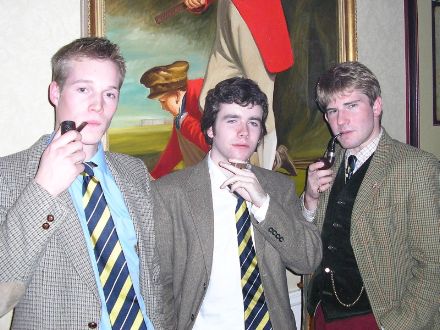
Just when you think you’re about to finish your dissertation, an epidemic of good times breaks out. Here are a few photos of late. (more…)
With C. in Yemen
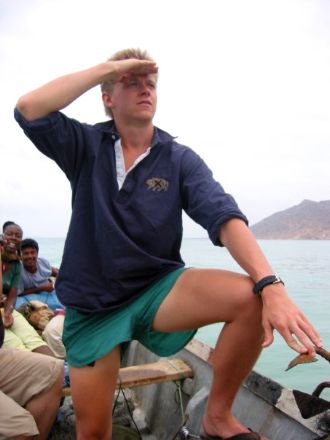
When Christopher C. was a wee lad, his daddy would bounce him on his knee and tell him of an island in the Indian Ocean named Socotra where the streets were paved with gold.
Lately, after reading the current price of gold on the Paris market in the Yemen Financial Observer, Chris decided to launch an amphibious assault on the island and seize it for himself.
Above, C. is seen leading what Chris Moreland called “the most unimpressive invasion force the world has ever seen”.

Once the expeditionary force made landfall, transportation by big ole Arab rowboat was considered logistically unsound, so the crack squad headed inland towards the capital of Socotra by means of a handy Japanese pick-up truck. Socotra! Where the streets are paved with gold!
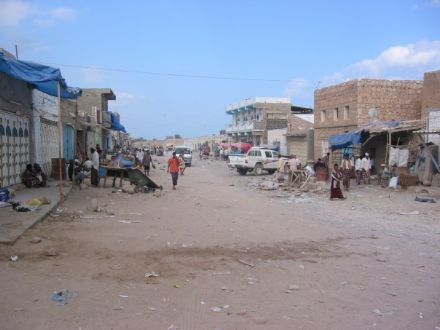
Unfortunately, like everything else his father ever told him, it was a lie.
Unless ‘gold’ is Arabic for ‘dirt’ and ‘paved’ is Arabic for ‘unpaved’, which would make Arabic a dashed silly language.
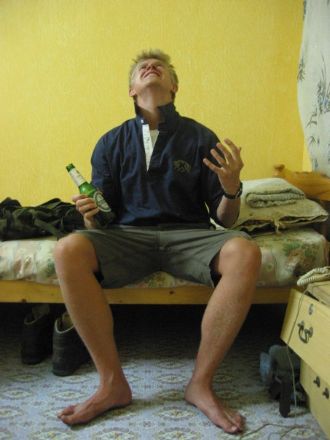
Disappointed with his anticlimactic conquest, Chris returned to the mainland where his rented room awaited.
There, he picked up a bottle of non-alchoholic beer, cursed the Gods, and questioned whether life really had any meaning after all.
The Inverness IVs Head
Today we had the pleasure of participating in the Inverness IVs Head Race. It brought forth mixed results. The girls did really well, and one of the guys crews did really well. Our boat on the other hand managed to crash. Twice! But, you know, we added a dash of the spirit of Admiral Farragut, full speed ahead, etc., and still managed to finish the race. Only second to last. Pity the poor bastards who didn’t even manage to beat us. They would’ve had to have sunk or something not to have overtaken us.
Inverness is more or less the capital of the Highlands, thus it’s terribly far north. So far north that when we arrived I said “Why on earth would they stick a country so far north?” which most present found to be a generally amusing comment on the northerliness of our current position until one chap said “Well I’ve been skiing in Trondheim”. Mark my words, whenever one makes a salient point, there’s always someone who’s been skiing in Trondheim.
Nonetheless, we managed to return to St Andrews in a shockingly quick under three hours. I found a few minutes to chat online with Allison Burbage, who in conversation emphathised with the feeling that it is sometimes such a burden to be superior to so many people. Allison would know; she’s superior to most. Then she went away to nurse a G&T in the neighboring dorm room. These crazy kids.
For Their Tommorrow, We Gave Our Today


Strange as it may seem, Remembrance Day is perhaps my favorite time in the entire British year. It is somewhat surprising that despite the cultural revolution of the past few decades, despite the intellectual, academic, and political assaults on tradition, history, the military, and the time-honoured institutions of this realm, Remembrance Day remains and is widely commemorated. Three times this Remembrancetide I had the opportunity to partake in the annual two minutes silence: first, on the eleventh hour of the eleventh day of the eleventh month (Remembrance Day itself), then the following evening while watching the unbeatable Festival of Remembrance at the Royal Albert Hall on television, then the following morning at the Remembrance Sunday chapel service, which was followed by the joint service of town and gown at the War Memorial.
It is my firm belief that you can discern a great deal about a country from its ceremonial culture. From the naked paganism of Nazi Germany and the Stalinist banality of Soviet Russia to the splendid majesty of Great Britain and the restrained republicanism of the United States, rituals are not empty acts, but are indeed indicative of an inner soul, an essence.
Most of our readers will not be familiar with the workings of Remembrance Day in Britain. The climax to a typical Act of Remembrance is the two minutes of silence in remembrance of and thanksgiving for the great sacrifice made during all wars. Usually, there are two particular brief epigrams of sorts read, one before and one after the two minutes of silence.
They shall grow not old, as we that are left grow old:
Age shall not weary them, nor the years contemn.
At the going down of the sun and in the morning
We will remember them.
We will remember them.
When You Go Home,
Tell Them Of Us And Say,
For Their Tomorrow,
We Gave Our Today.
The two minutes of silence is one of the few remnants of dignity in this land. Two minutes in which the entire nation comes to a halt. Railway stations, public streets, shops, offices, even the busy stock exchange come to a complete halt as we stand, silently, to remember uncountable deeds and intangible sacrifice.
America, of course, does not have the culture of Remembrance Day, but celebrates the day as Veterans Day instead. The United States was exposed to the massive slaughter of modern warfare a full fifty years before the Great War so shocked Europe. To this day, no war has claimed the lives of as many Americans as did the Civil War, which led to the creation of Memorial Day. One of the many blessings bestowed upon our country is that we have never had to suffer on such a great scale in our own homeland again, while Europe has witnessed warfare as recently as a few years ago in the Balkans.
The Balkans was where it all started, after all, on that fateful day in Sarajevo, June 1914. The greatest reflection I have read this Remembrance Sunday was Gerald Warner’s column printed in the latest Scotland on Sunday. It is well worth registering with scotsman.com for. Read it.
Thoughts on NYU, et cetera
New York University is a very odd fish. It was founded (as the University of the City of New York) in the 1830’s as an academic refuge for the city’s Dutch Reformed and Presbyterians opposed to the very Episcopalian flavor of Columbia College, though it was never officially aligned to either denomination. Around the turn of the century when Columbia moved uptown to a brand spanking new beaux-arts campus NYU decided to follow suit by moving even further uptown and building their own classically-inspired campus. They kept their buildings in Greenwich Village, however, and by the 1970’s found the Bronx campus (University Heights) to be a burden on the old chequebook and sold it to the City.
In the meantime, NYU was known (and pretty much had been since it was founded) as a “commuter school”, which is to say that most (though not all) of its students were from around the metropolitan area who travelled from home to school and back again. This has completely changed in the 1980’s, as graduates who had done well for themselves (and other philanthropists) began donating large sums to NYU and it remade itself in the image of the normal residential university (again, like Columbia). Of course, having forsaken their proper campus they were stuck with a number of buildings around Greenwich Village and so pretty much began to buy up any building of any size that came onto the market in the neighborhood. [A commenter on Curbed.com says that NYU is probably the largest landowner in the City after Trinity Church. The largest landowner is actually the (Catholic) Archdiocese of New York, followed by Columbia University (which happens to own Rockefeller Center, among other things). After that, I’m not sure but NYU probably has more land, while I would think Trinity Chuch probably has higher returns for the particular land they own.] NYU is now an almost entirely residential university in that even if its students are not living in dorms they are almost certainly not living with their parents nearby. Indeed, the proportion of native New Yorkers has fallen while those from other states and countries has risen markedly.
I’ve had a fair amount of experience with NYU. According to facebook.com I have seven friends there, though one spent his freshman year there and wisely thought “This place is for suckers” and transferred to Georgetown, while another friend (now graduated) never bothered to join the Facebook. Anyhow, in my final year of high school I had a good friend who was a year older than me (a Holy Child girl, troublemakers all) who went to NYU. Most weeks I would head down one afternoon after school (always Mondays actually; I’m a creature of habit and it suited her schedule) and have dinner and, to use the parlance of our times, “hang out” and “chill” until heading back up to yonder Westchester around 9 o’clock. As you can imagine, one met a fair number of NYUers during such perambulations and I have to say, though the young lady in question did have a pretty roommate from Connecticut (a ‘Darienfrau’ as Igby Slocum would say, though she was actually from Guildford), I not even once met a single person with whom I might want to voluntarily spend any of my time. They were, to a man, boring, self-obsessed nitwits, completey devoid of anything interesting. Though (I’m told) a number of Columbians were irate at me for having described their academy as “a fallen institution”, fallen though it is Columbia is still better than NYU. I have not nearly spent the same amount of time at Columbia as I have down at NYU and yet I’ve met interesting people from there. Also, my mother works at Columbia and though she likes to tell many hilarious stories of the freaks she has met amongst the studentry, she also tells of a number of very kind, nice, and interesting students she has had the occasion to meet. I very much doubt this would be the case if she was working at NYU. The most interesting people at NYU are actually the security guards who, although they all take their jobs terribly seriously (and rightly so), are usually much better for some decent chat than the students. Of course, Fordham students are superb and beat NYUers and Columbians any day of the week.
But who, then, are the other NYUers whom I count amongst my friends? They still manage to be interesting folks. Strangely enough none of the eight Violets I know are friends with one another. In addition to the Holy Child girl and the wise Georgetown transfer, there is 3) a fellow Thorntonian (guy), 4) a Bronxvillian guy, 5) a hilarious girl from Larchmont whom I’m good friends with, 6) and 7) two girls, both Californian, I know from the summer I spent at Oxford, and 8) a girl who is a member of my Upper East Side circle of friends. The reader will note the preponderance of females. NYU is very much a feminine university these days; I mean, heck, their athletic nickname is the Violets after all, not the Fighting Irish. Of the guys I know, one’s only their because he’s exceptionally talented in the realm of film, another knew well enough to transfer away from NYU, and the third is a fellow Thorntonian (Thorntonians are known for either surviving in adverse situations or cracking up and going loony, so that accounts for his survival to date). Every NYU girl complains about the lack of available men since NYU predictably attracts a large number of men of… err… “alternative lifestyle options”. Naturally this creates a situation, like the Anglican priesthood, where being a male at NYU one might automatically be tarred with suspicions of being “of an alternative lifestyle” and thus a very large proportion of self-respecting young men are deterred from even applying.
But back to Curbed. So NYU is building yet another dorm and many are complaining about their precious neighborhood being turned into the quarter for spoiled students. Ah well. I’m not terribly troubled. Greenwich Village to me is part of Manhattan’s vast underbelly, a term I use only half abusingly. It’s just that most places below Gramercy Park seem either too crowded or too weird for me to live. It’s not that the underbelly is ugly, there are some beautiful buildings and some quite charming parts. But as the Brits say about France, “lovely place, shame about the people”. And you know, if you go for the SoHo/Chelsea/Village scene, then fair enough. Enjoy it all you like. I’m just an Upper East Side kinda guy myself.
Walking the Dunes
Three sausages for breakfast, followed by reading from Gordon Brook Shepherd’s life of Empress Zita. Purchased my usual sugar doughring from Fisher and Donaldson and the latest Country Life from J&G Innes (all about London this week). The options for luncheon in hall were of asiatic origin so I boycotted and ate about half a loaf of buttered brown bread instead while reading Country Life in the Common Room of Canmore. There were a few people there; Adrian cataloguing the Catholic Truth Society pamphlets out of nothing better to do, Stefano sitting around waiting for his next tutorial, Liam lurking about, and “Ishmael” came in just to be social.
For a while we savaged Stefano because of his desire to show dirty films about Venetian courtesans in Canmore. Canmore, the Catholic Chaplaincy mind you, and Stefano is President of the Catholic Society. “Ishmael” and I slagged him off for being a dirty continental, which he just sort of brushed aside. We thought he was being a bit imperious, perhaps even episcopal, so we decided to turn the chair he was seated in into an impromptu sedia gestatoria. “Ishmael”, Adrian, Liam, and I each took one leg and raised His Foppishness aloft, processed him out of the Common Room, into the hallway, out the door, and into the street. We made as if we were going to give him the old heave-ho but eventually just put him down and ran back inside. Earlier he had taken off his shoes, and thus was stuck in the chair, in the street without any shoes on. By then we had gathered in the window to witness the poor man, yelling at us to carry him aloft “back into the palace”, gesticulating wildly, pointing out his lack of footgear. And we laughed. Oh, how we laughed. Eventually he got tired of our churlish manner and hopped back into the building, avoiding a puddle or two. “I hate you all,” he said, “and you didn’t carry me high enough,” then descending into ramblings about how at the next Catholic Society meeting the president should enter the room in a sedia. We resumed savaging him, and I had another slice of brown bread.
A little while later, I looked out towards the sea and the West Sands and felt them calling me forth. I had not gone for a walk along the beach yet this term, and it seemed as good a time as any. Though the sun was out I brought along my umbrella, just in case, and headed down past the Royal & Ancient Golf Club, past the putting green, and onto the Sands. Walks along the beach must be done at a very relaxed and leisurely rate. Every now and then I came across some driftwood or other such things that wash up on the beaches of Fife and gave them a little prod with my brolly and then, curiousity satisfied, carried along. I travelled about two thirds of the way down before seeking shelter from the breeze in one of the little dales within the dunes, took out some Marcus Aurelius that was hiding in my jacket pocket and had a little read. When I felt that my thirst for the wisdom of the ages was at least temporarily quenched, I decided to head back into town along the dune route. The beach is, as you would imagine, flat, whereas coming back along the dunes is a constant up and down through narrow sandy crevices with lots of reeds and tall grass on either side of you. If you ever visit St Andrews, you must go for a walk along the West Sands, and it’s advisable (if suitably agile) to walk at least partially along the dune paths.
Heading back into town, a Japanese couple asked me to take their photo in front of the R&A, and I duly obliged before slipping into the Quarto bookshop. The Quarto sells used books, and I had a good look around to see if there was anything new to peruse. I had a little read through a book on the history and traditions of the Channel Islands before heading back to hall, and here I am now, transcribing the day’s journey to you. Nothing left today but circuit training for the Boat Club, followed by a meeting of said august body. Hope it doesn’t last too long, else I’ll miss dinner. Some sort of pasta dish tonight; should be at least edible.
Previously: The West Sands
Autumnal Bliss
As I was walking to Mass this morning, I enjoyed listening to the crunch and brush of leaves underfoot that so wonderfully heralds the autumnal season. Today is one of those beautiful fall days when the sun is shining, the air is crisp, the wind slight, and the temperature slightly chilled but nowhere near uncomfortable.
Yesterday evening I had the pleasure of dining with Mr. Michael Fryer, who is surely the funniest man in all of Fife (at least whenever he’s in Fife; he’s an Ulsterman after all). We were both lamenting the fact that, in spite of St Andrews advertising itself as the university at which one is most likely to find one’s spouse, both of us are in our fourth year and remain as yet without prospective permanent ladyfolk. Right then, Dr. Brian Lang (the Principal and Vice-Chancellor, the man who runs the University) happened to walk into the pub and I considered walking over and demanding a refund, but the conversation turned to subjects greater in mundanity.
Another great thing about this time of year is the wearing of the poppy. No one seems to be quite sure when Remembrancetide begins and when the poppy should first be worn. In the absence of any official protocol to my knowledge, I usually judge that as soon as the Scottish Poppy Appeal start collecting money and distributing poppies, then is the time for wearing them. When it comes to Remembrance Sunday itself, I never miss the Festival of Remembrance broadcast on the telly, and neither should you. It’s a disgrace that it’s not broadcast on the web for those throughout the world unable to see it on their televisions. Still, it’s great to see so many poppies worn about town by young and old alike.
Later on last evening I had the added bonus of a pint and smoke with another Irishman, Mr. Alexander O’Hara of Galway. Alec and I are both fans of the pipe, and we enjoyed a good pint and some conversation a little late into the evening. Alec’s company is enjoyable because, like me, he is anti-social, and there are few things more enjoyable than being anti-social with other anti-social people. He’s in the midst of his doctoral thesis on Norwegian saints, which means he has to nitpick through various Latin manuscripts, translating them himself. Poor man! Still, he’ll have something to show for it at the end.
Well, unfortunately there’s work to be done so I must be off. A very happy All Saints’ Day to you all!
There’s Nothing Like A Good Fire
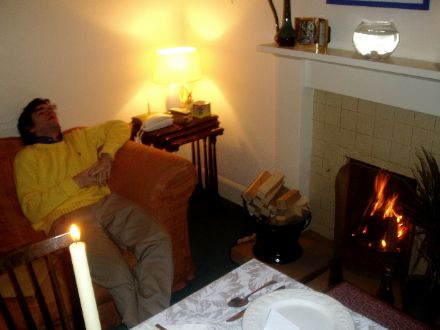
Here we observe the wastrel in his natural habitat: passed out on a sofa in a student flat at the University of St Andrews — the institution with the highest per capita number of wastrels in the British Commonwealth of Nations. In actual fact, Rob & Maria made an official visit up to Andreanopolis this weekend, and Abigail, Adrian, and Pamela graciously through a dinner party in their honour at Step Rock Cottage; Rob and Maria are exiled monarchs of the Catholic dinner party circuit.
The sad thing is this photo was taken before the party even started. I was exhausted from having woken up at 7:00am and spent the entire day rowing at Strathclyde Park that I just dragged myself over to the cottage on Gillespie Wynd at the appointed time in the evening and collapsed on the sofa in front of the crackling fire. It was sublime.
Below you can see Father Freddy, the resident chaplain at Step Rock Cottage, garbed in the appropriate chasuble for the liturgical season. He stands on the window sill blessing the herb garden all day long, or at least he usually does. At the moment he’s on his way to Downside for a retreat.
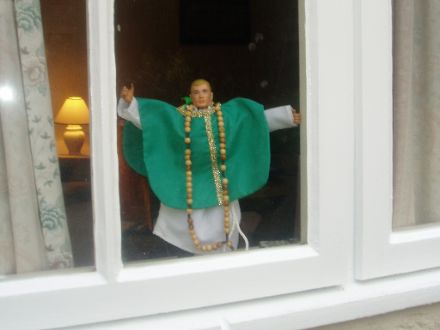
Flying the Flag
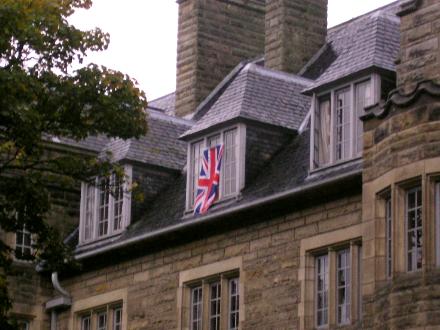
Despite the ban on students flying flags from their windows, I’m happy to say that four students hung Union Jacks out their windows in St Salvator’s Hall today to mark the Battle of Trafalgar. Two were on the front side of hall, two on the back. I took photos of the two on the front side. Mine is above, and the other one below (I don’t know to whom the room belongs).
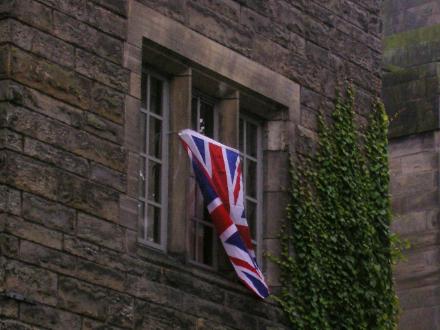
Search
Instagram: @andcusack
Click here for my Instagram photos.Most Recent Posts
- A Christmas Gift from the Governor December 24, 2024
- Oude Kerk, Amsterdam December 24, 2024
- Gellner’s Prague December 19, 2024
- Monsieur Bayrou December 18, 2024
- Dempsey Heiner, Art Critic December 17, 2024
Most Recent Comments
Book Wishlist
Monthly Archives
Categories


